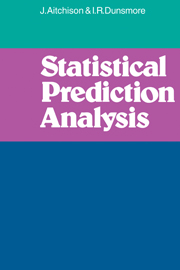Book contents
- Frontmatter
- Contents
- Preface
- 1 Introduction
- 2 Predictive distributions
- 3 Decisive prediction
- 4 Informative prediction
- 5 Mean coverage tolerance prediction
- 6 Guaranteed coverage tolerance prediction
- 7 Other approaches to prediction
- 8 Sampling inspection
- 9 Regulation and optimisation
- 10 Calibration
- 11 Diagnosis
- 12 Treatment allocation
- Appendix I
- Appendix II
- Bibliography
- Author index
- Subject index
- Example and problem index
10 - Calibration
Published online by Cambridge University Press: 12 October 2009
- Frontmatter
- Contents
- Preface
- 1 Introduction
- 2 Predictive distributions
- 3 Decisive prediction
- 4 Informative prediction
- 5 Mean coverage tolerance prediction
- 6 Guaranteed coverage tolerance prediction
- 7 Other approaches to prediction
- 8 Sampling inspection
- 9 Regulation and optimisation
- 10 Calibration
- 11 Diagnosis
- 12 Treatment allocation
- Appendix I
- Appendix II
- Bibliography
- Author index
- Subject index
- Example and problem index
Summary
The nature of a calibration problem
Calibration is commonly regarded as the process whereby the scale of a measuring instrument is determined or adjusted on the basis of an informative or ‘calibration’ experiment. For example, if we wish to calibrate an unsealed thermometer we might note the position x1 on the liquid scale when the thermometer is immersed in boiling water at atmospheric pressure, that is, corresponding to temperature t1 (= 100°C); and the position x2 when the immersion is in ice, say corresponding to temperature t2 (= 0°C). We might then divide the scale between x1 and x2 into 100 equal divisions so that, when the thermometer is immersed into some other substance, we are able to deduce very simply from the x-scale the corresponding temperature of the substance. In this example the use of the calibration experiment yielding trial records (t1, x1), (t2, x2) is straightforward since there is, or at least we are assuming that there is, a one-to-one correspondence between the x-scale and the temperature or t-scale. But the same type of problem arises commonly in a less simple form, for usually, as in the following examples, there is no unique x corresponding to a given t.
Example 10.1
Measuring water content of soil specimens. Two methods are available for obtaining the water content in soil specimens. The first method, performed in the laboratory, is very accurate but is expensive and tedious to operate. The second method, which can be performed on site, is much quicker and cheaper, but is less accurate.
- Type
- Chapter
- Information
- Statistical Prediction Analysis , pp. 181 - 211Publisher: Cambridge University PressPrint publication year: 1975



